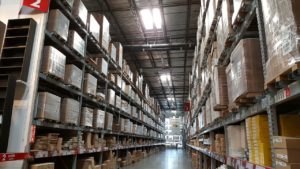Dakota Murphey discusses strategies to safeguard employees from heat-related illness and accidents within manufacturing.
 Maintaining optimal temperature control in warehouses, storage facilities and factories – all crucial buildings that keep interconnected supply chains ticking over – is not just essential for keeping productivity high and ticking regulatory compliance boxes. Temperature control plays a crucial role in ensuring worker health and safety, which, in the manufacturing space, is often a hot topic (no pun intended).
Maintaining optimal temperature control in warehouses, storage facilities and factories – all crucial buildings that keep interconnected supply chains ticking over – is not just essential for keeping productivity high and ticking regulatory compliance boxes. Temperature control plays a crucial role in ensuring worker health and safety, which, in the manufacturing space, is often a hot topic (no pun intended).
Figures from the last year have shown that nearly half of UK manufacturing employers have increased their investment in workforce health and well-being, which is reassuring. However, there is still a grey area surrounding temperature control in manufacturing facilities, even in light of this positive news.
With the inevitable rise in summer temperatures looming closer than ever – if often in a haphazard pattern – businesses in the manufacturing space must consider whether their temperature and environmental conditioning solutions are sufficient to keep employees working at safe and manageable temperatures this summer. Failing to do so could not just impact their safety and well-being, but also open the business as a whole to regulatory scrutiny and reputational damage.
Taking on board recommended HSE (Health & Safety Executive) guidance pertaining to workable temperatures, this article explores how companies can establish proper temperature control in their manufacturing facilities.
Temperature health and safety risks in manufacturing
Environments prone to excessive heat or cold can lead to a wide range of health and safety hazards that impact individuals and the company as a whole. From fatigue and dehydration to heightened risks of accidents, organisations can ill afford to overlook temperature management in their buildings.
Recent ONS statistics suggest there are currently 138,440 manufacturing businesses in the UK. The sector itself statistically employs roughly 2.1 million people in 2024, and despite two years of low growth, is projected to amount to $142.7 billion this year (CAGR 2024-2029). While aggregating specific facility numbers is difficult, it’s safe to assume that most of these companies have some form of building requiring temperature control and ventilation to keep operations moving.
Manufacturing itself encompasses a broad scope of products from medical devices, metals, and textiles to consumer goods like food, clothing, electronics and even industrial machinery and vehicles. Encompassing the complexity of facilities within each sub-sector of product manufacturing would be challenging, but taking this one example illustrates succinctly just how vital temperature control is.
“Maintaining a good working temperature in our food manufacturing facility is something we take very seriously,” reveals Jon Jeffryes at Panificio Italiano, a wholesale bread supplier with a 45,000-square-foot production facility in Buckinghamshire. “Not only does it ensure the quality and safety of our artisan bread products, but it also plays a vital role in safeguarding our production team’s health and well-being.
“They are exposed to industrial ovens and heat-generating equipment constantly, which is why we have the best-quality cooling systems, ventilation and air conditioning in place to prevent fatigue and heat stress. We also enforce regular breaks to prioritise their comfort and safety, as we know that without a healthy workforce, we would not be where we are today.”
 Taking on board the market and workforce size, here are some of the most common risks that these employees likely face every day:
Taking on board the market and workforce size, here are some of the most common risks that these employees likely face every day:
- Heat stress: High temperatures and humidity can cause heat stress for employees working in hot environments like bakeries, foundries, and others. Heat stress sees body heat and heart rate increase, excessive sweating and symptoms like fainting, heat rash, cramps, and even heat stroke, which can be life-threatening if not detected early.
- Fatigue: Prolonged exposure to hot temperatures indoors can leave employees exhibiting excessive physical and mental fatigue. While most mild symptoms are easily treatable, constant fatigue can result in reduced alertness and increase the risk of workplace accidents and errors.
- Dehydration: Dehydration can seriously affect employee health and their ability to work safely. Working in heat-stress-inducing conditions should warrant sufficient hydration before work and regular water consumption during work. If water loss is greater through excessive sweating, they should drink more and often consume drinks that have added salt.
- Respiratory issues: Facilities that generate fumes, dust, and debris in excess can make employees respiratory problems worse. This can also be exacerbated when working outdoors, even temporarily, in excessively cold or hot environments, as the environment may make workers struggle to breathe properly.
One important factor regarding these heat-related health and safety issues is the knock-on effect they can have on concentration, communication, and awareness. Stress, fatigue, dehydration, and breathing difficulties can affect concentration, which, in high-risk situations can drastically exacerbate the chances of serious, fatal or catastrophic injury.
One recent example saw the death of a worker and the manufacturing company receiving a £120,000 fine for failing to uphold correct control measures. This illustrates just how important constant oversight is, which is inherently easier when temperatures are less obstructive.
HSE guidance on temperatures in facilities
The Workplace (Health, Safety and Welfare) Regulations require employers to ensure indoor temperatures are reasonable, which depends on the work activity and the environmental conditions.
Whether work is being done indoors or outdoors, employers must comply with the relevant Approved Code of Practice (ACoP) and Management of Health and Safety at Work Regulations 1999, while being mindful of their manufacturing facility’s specific risks and conditions.
For instance, the manufacturing Code of Practice suggests the minimum indoor working temperature be at least 16°C or 13°C for work that is more strenuous.
Interestingly, there is no maximum temperature for workplaces, but all workers are entitled to an environment where health and safety risks are properly controlled. Heat and cold are classed as hazards and thus, come with legal obligations from a manufacturing employer to assess and mitigate.
As manufacturing is connected to a broad range of sectors itself, employers should pay close attention to specific HSE guidance related to their industry. For instance, in food and drink manufacturing, employers in bakeries and sugar confectionaries will have specific HSE guidance for them which may differ from those in slaughterhouses or grain mills. As such, facilities in these spaces will have unique requirements and, by extension, health and safety risks.
Implementing effective temperature control strategies
 As a top-level guide, however, employers in manufacturing can mitigate the risks of excessive temperatures proactively. Consider the following key measures and improvements to your facility to safeguard your employees during UK hot summer days.
As a top-level guide, however, employers in manufacturing can mitigate the risks of excessive temperatures proactively. Consider the following key measures and improvements to your facility to safeguard your employees during UK hot summer days.
- HVAC installations: Ensure that the facility has sufficient heating, ventilation and air conditioning to regulate indoor temperatures and maintain a good level of healthy air quality. This will drastically improve worker health and well-being in day-to-day operations.
- Review machinery maintenance schedules: Consider adjusting preventive maintenance strategies to better regulate excess heat generated by machinery and equipment to prevent them from raising indoor temperatures too high.
- Personal protective equipment (PPE): Provide workers with sufficient, approved PPE for specific tasks that could expose them to environmental conditions that could exacerbate pre-existing symptoms.
- Improved break and refreshment schedules: Ensure there is adequate space for them to warm up, cool down, refresh and hydrate regularly when working in high or low temperatures.
- Employee training: Train and upskill workers using recommended, HSE-approved programmes to help them recognise signs and symptoms of heat stress, dehydration, fatigue, and more that could compromise their individual and collective safety.
Keep on top of temperature management
The manufacturing sector remains a cornerstone of the UK economy and is responsible for millions of skilled workers. However, it goes without saying that these workers need to be protected all year round from any heat-related illnesses, accidents, and conditions.
According to recent RIDDOR data, there were 15 fatal injuries to workers in manufacturing in 2022/23 alone, compared to an annual average of 19 fatalities over five years, with 46,000 suffering non-fatal injuries and 91,000 workers suffering from work-related ill health. Despite the broad workforce size, illnesses, accidents, and injuries stemming from heat must be mitigated all the time.
Implementing strategies now will be the best way forward in safeguarding employees as more enter this fulfilling and enriching industry. Given evolving global environmental conditions as well, positive management gives manufacturers the best possible chance to thrive sustainably and progressively in the decades to come.
Why should you subscribe to the SHP newsletter?
Do you want the very latest health and safety news, guidance, job listings and expert opinions sent straight to your inbox every Tuesday and Thursday?
The SHP newsletter is essential reading – sign up today to get your hands on all this!

 Maintaining optimal temperature control in warehouses, storage facilities and factories – all crucial buildings that keep interconnected supply chains ticking over – is not just essential for keeping productivity high and ticking regulatory compliance boxes. Temperature control plays a crucial role in ensuring worker health and safety, which, in the manufacturing space, is often a hot topic (no pun intended).
Maintaining optimal temperature control in warehouses, storage facilities and factories – all crucial buildings that keep interconnected supply chains ticking over – is not just essential for keeping productivity high and ticking regulatory compliance boxes. Temperature control plays a crucial role in ensuring worker health and safety, which, in the manufacturing space, is often a hot topic (no pun intended).  Taking on board the market and workforce size, here are some of the most common risks that these employees likely face every day:
Taking on board the market and workforce size, here are some of the most common risks that these employees likely face every day: As a top-level guide, however, employers in manufacturing can mitigate the risks of excessive temperatures proactively. Consider the following key measures and improvements to your facility to safeguard your employees during UK hot summer days.
As a top-level guide, however, employers in manufacturing can mitigate the risks of excessive temperatures proactively. Consider the following key measures and improvements to your facility to safeguard your employees during UK hot summer days.